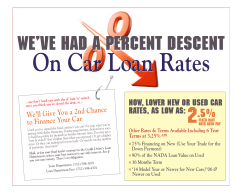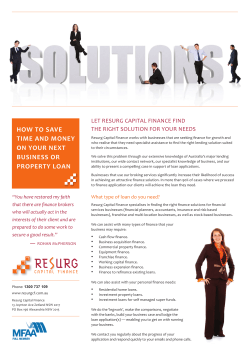
SHGBLP - Study on Loan Utilization Patterns in Chittoor District of AP
SHG BANK LINKAGE PROGRAMME: Study on loan utilization patterns in Chittoor District of AP Conducted by APMAS Presentation by Dr. K. Raja Reddy, krajareddy@apmas.org OBJECTIVES OF THE STUDY • To understand the distribution pattern of large loan amount • To study loan disbursement process adopted by banks and groups. • To learn about purposes and utilization of loan amount by members. • To know the repayment trends and its impact on family consumption, indebtedness and group saving, etc. STUDY TEAM WITH SHG MEMBERS SAMPLE COVERED • • • • • • • District chittoor Rev. divisions Mandals Bank Branches Villages SHGs SHG members : 1 : 3 : 3 : 3 : 9 : 18 : 54 PROFILE OF THE MEMBERS • Ag. and ag. labor are the primary occupations • Dairy is the principle secondary occupation • Majority are small farmers followed by landless • Most of them are neo-literates • All are having white ration cards • But most of them are non-poor • Majority are BCs and OCs • Most of them living in tiled and pucca houses ACCESS TO LOANS • All the SHGs obtained 3-4 loans from the banks • Rs. 15,000-30,000 avg. cum. loan from banks • 2-5 loans with Rs. 5,000-10,000 from group corpus • RF mostly either made it as FD or lent to members • Very few groups got subsidy loans from DRDA • CIF is only to few SHGs and members MONTHLY THRIFT • Either Rs. 30 or Rs. 50 is the monthly thrift • Member cum. savings from Rs. 2000 to Rs. 4000 • Savings distribution is only in very few cases • Many groups enhanced their monthly savings • Each member saving Rs. 10 pm in VO APPRAISAL • Most of the SHGs are ‘A’ grade • Loan size is mainly depend on group corpus • Regularity in the repayment of earlier loan • Loan size generally 1:5 • RF and FD are the informal surety • More idle funds/ bullet payment LENDING NORMS • Equal distribution is very common in SHG-BL • 20 to 36 months is the loan payback period • SHGs charging the same interest rate charged by the banks • SHG & BM jointly decided the loan instalments & amount • Monthly repayment of both principle & interest • A portion of loan (10% to15%) made it as FD LOAN UTILIZATION • Milk animals between Rs. 8,000 and Rs.12,000 • House construction worth Rs. 2 to 5 lakhs • Meet the expenses of daughter’s marriage • Ill-health of the household members • Meet the expenses of children education and to repay private loans • Existing economic activities-dairy, petty business, agriculture inputs etc. • Little portion of the loan used for HH miscellaneous expenses LIVELIHOODS NON-PRODUCTIVE INVESTMENTS HEALTH EDUCATION HOUSING MARRIAGES LOAN REPAYMENT SOURCES • Household income is the major source • IGA taken up with loan is another source • Amount obtained under PV adjusted to loan instalments • Money transfers from SB A/c to loan account • Loans from savings to delayed members DELAYED PAYMENT REASONS • Delayed payers- loan spent on nonproduction purposes • Less availability of work & crop failure • Less income from the household activity • Ill-health of one of the household members • Willful default is almost absent REPAYMENT STRATAGIES • Repayment is more than 95 percent • Repayment strategies • Adjustment of savings • Loans from internal funds/savings to defaulters • Loans from external sources • Bullet payment of last 2 or 3 instalments to get repeat loan RATE OF INTEREST • Rate of interest varies from bank to bank • Increase in banks’ interest rates from 9% to 12% • Reduction in interest rates (Rs. 2-1) by the SHGs • To avail 3% interest per annum (PV) SHGs regularly repaying bank loans • But stopped repaying loans borrowed from group funds • Diminishing method of interest • Interest will add to principle for every 3 or 6 months PAVALAVADDI- 3% Interest rate • All SHGs benefited with pavalavaddi • All the members benefited in the group • Once in every 6 months received from DRDA • Amount varies from 5 to 10 thousand rupees • In many SHGs used to repay loan inst. • Some added to group corpus for int. lending OPERATIONAL COST • Between Rs. 500 and Rs.1000 • Meeting the expenses in two ways • Deducting at the time of disbursement • Paying separately without using group funds and loan amount • It could be because of more awareness PROBLEMS REPORTED • Large instalment amounts • Less no. of instalments • No information about the FDs of loan and Revolving fund • No trainings on IGAs IMPACT • About 1/3rd of cases no income creation • Income varies from Rs. 500 to Rs. 1500 per month • 3-4 hours of additional employment generation • Employment to husband and wife rarely children • No additional savings in any form • No increase in expenditure on food items • Asset creation-Owning milk animals, improvement in business, house construction IMPACT • Much pressure on women to repay instalments regularly • Children education improved • Repaid old debts • Loan utilization - decreased the dependency on Money lenders • Regular repayment - increased the dependency on money lenders IMPACT ON SHGs • Large loans to members • More access to formal credit • More savings in VO • More respect in the bank EXPECTATIONS • Large loans between 2 to 3 lakhs • 50% of the loan for IGA and another 50% to repay private loans • IGA includes existing activities-dairy, petty business, agriculture inputs • No one requested any training on livelihoods Thank You
© Copyright 2025












